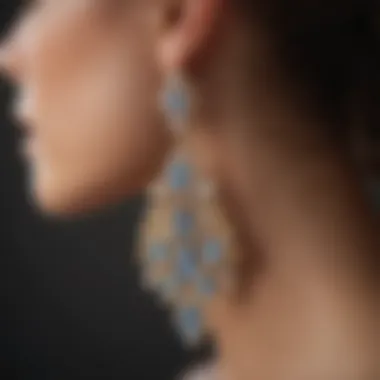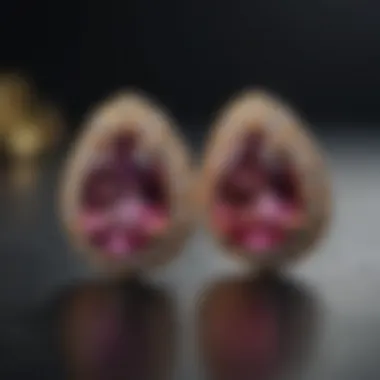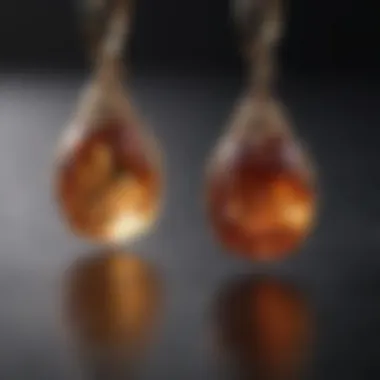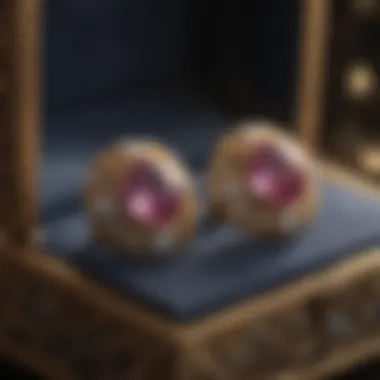Comprehensive Guide to Cleaning Earrings Effectively


Intro
Earrings serve not only as adornments but also as reflections of personal style. The choices in shapes, materials, and designs vary greatly. This diversity makes caring for them essential. Proper cleaning techniques ensure that earrings maintain their luster and continue to enhance one’s appearance. Just as important, it supports a hygienic environment, preventing irritations or infections caused by accumulated dirt and oils.
In this guide, we will explore effective methods and best practices for cleaning earrings. We will also offer insights on how to manage different materials, ensuring their longevity. Ultimately, having clean earrings improves both their aesthetic charm and personal hygiene, allowing users to wear them with confidence.
Foreword to Earring Maintenance
Cleaning earrings is not merely a cosmetic task; it plays a vital role in prolonging the life and ensuring the hygiene of these accessories. Regular maintenance can keep them looking new while preventing the build-up of dirt and oils. If neglected, earrings can accumulate grime, which can lead to skin irritations or allergic reactions, particularly for those with sensitive skin. Thus, understanding the importance and methods of earring cleaning is essential for both wearability and aesthetics.
Importance of Cleaning Earrings
Earrings often come into contact with sweat, dust, and products like hairsprays or perfumes. Regular cleaning helps remove these contaminants, promoting hygiene and preventing potential infections. Beyond health considerations, clean earrings maintain their brilliance and charm, allowing them to shine as the jewelry pieces we adore. Moreover, cleaning can reveal any damages that might require professional attention. Therefore, setting up a cleaning routine is crucial.
Types of Earrings and Their Materials
Earrings are diverse in both design and material, affecting the methods used for cleaning them. Understanding the composition of your earrings provides insight into the appropriate care needed.
Stud Earrings
Stud earrings are characterized by their simplicity and versatility. They often have a post that goes through the earlobe, making them easy to wear for extended periods. Common materials for stud earrings include gold, silver, and gemstones. Their key feature is the minimalist design, which allows them to match various outfits. With minimal moving parts, stud earrings are generally easier to clean and maintain compared to more complex styles. Their advantage lies in their everyday usability, though their understated nature might not appeal to those seeking a more dramatic flair.
Hoop Earrings
Hoop earrings are circular and can come in various sizes, making them a bold fashion statement. Their notable characteristic is the aesthetic versatility they offer, allowing wearers to dress them up or down effortlessly. Often made from metals such as gold or silver, they require specific care due to their shape. Cleaning hoop earrings can be slightly more complicated, as it may not be as straightforward to access crevices than in stud earrings. However, their advantage is that they often have a long-lasting style, which can endure trends.
Dangle Earrings
Dangle earrings feature elements that hang below the earlobe, creating movement and visual interest. These earrings can be quite intricate and are often made with various materials, including beads, metal, and stones. Their key attribute is their ability to add flair to any outfit. However, the complexity in design may require more careful handling during cleaning to avoid damaging delicate components. The unique feature of dangle earrings is their dynamic appearance. Their drawback might be their added weight, which can sometimes be uncomfortable for prolonged wear.
Clip-on Earrings
Clip-on earrings provide an alternative for those who do not have pierced ears. They function by using a hinged mechanism to grip the earlobe. A key characteristic of clip-on earrings is their accessibility for everyone, regardless of piercing. Made in materials similar to traditional earrings, they also require careful cleaning. One benefit is the broad variety available, accommodating different styles. However, their tightening mechanism may require more attention during maintenance to ensure comfort and longevity.
Understanding the types of earrings and materials involved in their construction aids in the cleaning process. Each type has its unique characteristics that require specific approaches, which will be explored in detail as we progress in the guide.
Recommended Cleaning Techniques
Effective cleaning techniques hold significant importance in maintaining the beauty and hygiene of earrings. Jewelry, especially earrings, encounters dirt, oils from the skin, and environmental pollutants with daily wear. Without proper care, these elements can dull the shine and lead to potential infections, especially for sensitive ears. Therefore, understanding varied cleaning methods ensures that your earrings remain not only visually appealing but also safe to wear.
Basic Cleaning Methods for Everyday Use
Mild Soap and Water Solution
Using a mild soap and water solution is one of the simplest and most effective methods for cleaning earrings. This solution effectively removes everyday grime without causing harm to the material. The key characteristic of this method is its gentle approach, making it suitable for most earring types, including delicate metals and various stones.
The unique feature of mild soap is its ability to break down oils and dirt while being non-abrasive. This makes it a popular choice for regular maintenance, as it can easily be used at home without the need for specialized tools. However, care must be taken to rinse thoroughly to avoid any soap residue, which could affect skin sensitivity.
Using a Soft Cloth
Employing a soft cloth is another highly recommended method for earring cleaning. A soft cloth is typically made from materials that do not scratch or damage the surface of the earrings. The primary benefit of this technique is its simplicity; it requires no additional cleaners. Just a simple wipe with a soft cloth is often sufficient to restore shine and remove surface-level dust and fingerprints.
Its unique feature lies in its effectiveness for polishing earrings, particularly those made from metals like gold or silver. Regular use can significantly enhance the luster of earrings without altering their structure. However, for deeper cleaning, this method might not suffice, emphasizing the need for a combination of methods for comprehensive care.


Professional Cleaning Options
For those seeking a deeper clean, professional cleaning options offer advanced techniques that ensure maximum care. This approach typically includes specialized equipment and methods not available at home.
Ultrasonic Cleaners
Ultrasonic cleaners use high-frequency sound waves to create tiny bubbles in a cleaning solution, which can effectively remove dirt and debris from earrings. These machines are particularly beneficial for intricate designs where dirt may conceal itself in hard-to-reach areas. The key feature of ultrasonic cleaning lies in its thoroughness. It can clean multiple pieces simultaneously and reach every crevice without manual scrubbing.
The downside, however, is the need for careful handling. Some materials, like pearls or certain soft stones, may not withstand ultrasonic cleaning. Thus, users must be cautious and aware of their earrings' specific materials before opting for this service.
Steam Cleaning
Steam cleaning is a professional method that employs high-pressure steam to remove dirt and grime. This technique is beneficial due to its effectiveness in sanitizing and removing buildup without harsh chemicals. The important characteristic of steam cleaning is that it can revive the brilliance of earrings while also being gentle on the materials.
One major advantage of this method is that it not only cleans but also sanitizes the jewelry, providing an added layer of care. However, similar to ultrasonic cleaning, it is crucial to check the suitability of the earrings for steam cleaning, as certain materials may not be recommended.
Material-Specific Cleaning Guidelines
Cleaning earrings requires a tailored approach, based on the materials involved. Each type of earring material has unique characteristics and requires specific cleaning methods to maintain their aesthetics and longevity. Understanding how to handle different materials is vital for preserving both their shine and structural integrity. This section will delve into proper techniques for cleaning gold, silver, gemstone, and costume jewelry. By following these material-specific guidelines, you can ensure your earrings look their best and endure the test of time.
Cleaning Gold Earrings
Gold earrings demand a gentle touch, as they can easily be scratched or damaged. Begin by mixing a few drops of mild dish soap with warm water. Use a soft cloth or a cotton swab to gently clean the earrings. Be careful to avoid excessive force, which could tarnish or scratch the gold surface. Rinse the earrings thoroughly under lukewarm water, ensuring no soap residue remains.
After rinsing, dry them immediately with a soft, lint-free cloth. This prevents water spots and maintains the brilliant shine of gold. Regular cleaning helps to avoid buildup of grime, which can dull the appearance. A deeper clean can be done by visiting a jeweler for professional polishing.
Cleaning Silver Earrings
Silver earrings require special attention due to their propensity to tarnish. To clean silver, first create a solution with warm water and a teaspoon of baking soda. Soak the earrings for a few minutes, then gently rub with a soft cloth to lift off tarnish. Be cautious with intricate designs where dirt may settle. Rinse in clean water and dry thoroughly afterward; any moisture left can lead to further tarnishing.
For persistent tarnish, use a silver polish specifically designed for jewelry. Avoid using abrasive cleaners, as they can scratch the surface of silver, leading to diminished shine over time.
Cleaning Gemstone Earrings
Cleaning gemstone earrings requires an understanding of individual stone properties. Different gemstones respond differently to cleaning agents, making a tailored approach necessary. For example, diamonds and sapphires can withstand ultrasonic cleaners. However, softer stones like opals and pearls require delicate handling.
Cleaning Specific Stones
When working with specific gemstones, the general principle is to use lukewarm water and mild soap for cleaning. Soak the jewelry for a short period, followed by gentle wiping with a soft brush to dislodge dirt. After cleaning, rinse thoroughly and dry with a soft cloth. It is important to be aware of specific cleaning needs for each stone. For opaque stones, avoid soaking as water can compromise the setting.
Avoiding Damage to Settings
When cleaning gemstones, you must also consider the safety of their settings. Many stones are secured by prongs or bezels. These settings can be delicate, especially on vintage or intricate pieces. To avoid damage, ensure that no cleaning solutions seep into the settings, which could weaken them.
Using a soft cloth around the area will help lift dirt without putting pressure on the stone. Avoid ultrasonic cleaners for softer stones and pieces with glued settings, as they can lead to detachment or fractures.
Cleaning Costume Jewelry
Costume jewelry often features a combination of varied materials including synthetic stones, base metals, and plastic. Given this diversity, one must take a cautious approach when cleaning. Use a damp microfiber cloth to remove dust and fingerprints. If deeper cleaning is needed, create a solution of mild soap and warm water. Dip a soft cloth or sponge into this, making sure it's not overly saturated, then wipe gently.
Rinse off any soap residue with a clean cloth barely dampened with water. It's essential to avoid soaking costume jewelry to prevent damage to glues and finishes. Always allow these items to air dry completely before storing.
In summary, knowing how to clean earrings according to their material is key to maintaining their beauty and hygiene. Following these specific guidelines ensures that your jewelry remains in impeccable condition, whether it’s gold, silver, gemstone, or costume pieces.
Common Mistakes in Earring Cleaning


Cleaning earrings requires precision and care. However, many individuals make common errors that can lead to damage or reduced effectiveness in maintenance. Understanding these mistakes will help you avoid pitfalls and ensure your jewelry remains beautiful and hygienic.
Using Harsh Chemicals
One of the most prevalent mistakes is using harsh chemicals for cleaning earrings. Many people believe that stronger solutions will yield better results. This misconception can be detrimental. Harsh chemicals can corrode or tarnish delicate materials like silver or gemstones. Instead of improving the appearance, they can strip away finishes and damage intricate settings.
Instead of reaching for anything with a heavy-duty label, opt for solution specifically designed for jewelry. A pH-balanced cleaner or a mixture of mild soap and water is generally safer. When using any solution, conduct a patch test on an inconspicuous area first to ensure no adverse reactions occur.
Neglecting Regular Maintenance
Neglect can be another fast track to damage. Many individuals underestimate the importance of regular cleaning. Over time, earrings can collect dirt, oils, and even bacteria from daily wear. This accumulation not only affects their appearance but can also pose a health risk, particularly for items worn in pierced ears.
By establishing a routine for earring maintenance, you can avoid excessive buildup. Consider cleaning them gently once a week or after particularly active days. This small habit has the potential to extend the life of your pieces significantly.
Remember: Regular checks also provide an opportunity for you to inspect for any signs of wear or loose settings, allowing for timely repairs.
In summary, steering clear of harsh chemicals and committing to a regular cleaning schedule can make a substantial difference in the longevity and beauty of your earrings. Keeping these concepts top of mind will assist in maintaining your jewelry collection effectively.
Tools and Supplies for Effective Cleaning
Tools and supplies play a critical role in cleaning earrings effectively. The right tools can make the cleaning process simpler and more efficient, ensuring that your jewelry retains its shine and integrity. Without proper tools, the cleaning may not reach the desired results, leading to potential damage or contamination. Thus, it is essential to understand the various tools available and the cleaning solutions that can enhance the cleaning experience for different types of earrings.
Essential Cleaning Tools
Soft Brushes
Soft brushes are integral to the cleaning process. They gently reach crevices and corners that are often missed by other methods. The key characteristics of soft brushes include their delicate bristles, which are designed to avoid scratching surfaces while still providing adequate cleaning power.
These brushes are a popular choice for cleaning earrings because they can effectively remove dirt and residue without causing harm. A unique feature of soft brushes is their ability to adapt to different types of materials. For example, a brush meant for delicate gemstones will have softer bristles than one used for more durable metals. Advantages of soft brushes include their versatility and effectiveness in providing thorough cleaning. However, they require regular washing to prevent buildup of dirt, which is a consideration for earring maintenance.
Microfiber Cloths
Microfiber cloths are another favored tool for earring cleaning. Their soft texture and fine fibers allow for gentle cleaning without risk of scratching. The key characteristic of microfiber cloths is their ability to trap dust and oils, which makes them an effective option for polishing earrings.
These cloths are popular due to their reusable nature and ease of cleaning. A unique feature of microfiber cloths is their capability to absorb moisture, which can be beneficial when drying off earrings after a wash. Among their advantages, they provide a lint-free finish and can be washed multiple times, which enhances their cost-effectiveness. However, it is important to ensure that the cloths remain free from harsh chemicals to maintain their integrity over time.
Recommended Cleaning Solutions
pH-balanced Solutions
Using pH-balanced solutions is crucial when it comes to maintaining the health of earrings. These cleaning solutions are specifically designed to match the pH level of the skin. The key characteristic of pH-balanced solutions is that they prevent irritation when earrings come into contact with the skin.
These solutions are a beneficial choice because they ensure that materials like silver and gold are not adversely affected. A unique feature of pH-balanced solutions is their gentle formulation, which ensures effective cleansing while safeguarding the surface of the earrings. Advantages include their overall safety and compatibility with a variety of materials, but they may not effectively remove heavier tarnish or buildup without additional scrubbing.
Natural Alternatives
Natural alternatives for cleaning solutions have gained traction due to their eco-friendly nature and safety. These solutions, often consisting of ingredients like distilled vinegar or baking soda, provide an effective yet gentle way to clean earrings. The key characteristic of natural alternatives is their non-toxic composition, making them suitable for sensitive skin.
They offer a beneficial option for those who prefer to avoid chemicals in their cleaning routine. A unique feature of these alternatives is their availability and affordability, as many can be found around the household. While they work well for general cleaning, there might be limitations regarding their effectiveness on stubborn stains or buildup, which could require supplementary methods to achieve desired results.
Remember: Selecting the right tools and cleaning solutions is essential for maintaining the beauty and longevity of your earrings.
Maintaining and Storing Earrings


When it comes to the longevity and aesthetic appeal of earrings, maintaining and storing them properly is crucial. Ignoring this aspect can lead to tarnishing, scratches, and even loss. Many people invest considerable time and money into their earring collections, yet they often overlook the significance of proper maintenance and storage practices. By implementing effective strategies, you can not only preserve the beauty of your earrings but also ensure their hygienic condition for regular use.
Optimal Storage Conditions
The environment where earrings are stored plays a vital role in their preservation. Ideal storage conditions involve controlling factors like light, humidity, and temperature.
- Light: Direct sunlight can lead to fading and weakening of certain materials. It is advisable to store your earrings in a dark place or within boxes designed to block out light.
- Humidity: Excess moisture can contribute to tarnishing, especially for metal earrings. Using silica gel packets or a dehumidifier can be beneficial in maintaining a dry environment.
- Temperature: Keeping earrings in a stable, moderate temperature prevents warping or damage. Fluctuations may cause materials to expand or contract, leading to misalignment or breakage.
Using a dedicated jewelry box with compartments or a soft-lined drawer can enhance storage. These solutions create a protective space that minimizes movement and prevents items from scratching against each other.
Preventing Damage When Storing
In addition to optimal environmental conditions, taking steps to prevent physical damage during storage is essential. Consider the following practices:
- Separating Pieces: Avoid tangling by storing earrings separately. Hooks and wires can get caught in each other, causing breakage.
- Using Soft Liners: Place a soft cloth or fabric within your jewelry box. This adds an extra layer of protection against scratches and other forms of physical harm.
- Clipping Props: For clip-on earrings, always ensure they are unclipped before placement in storage. Clipping them together can weaken the spring mechanism over time.
- Avoiding Excessive Pressure: Stack earrings carefully to prevent them from being crushed. If using a drawer, ensure that the drawer closes gently without compressing the contents.
"Proper storage helps maintain the integrity of your earrings and extends their lifespan significantly."
Consulting Professionals
In the realm of jewelry care,ing earrings is not always straightforward, especially when it comes to intricate designs or valuable pieces. This is where consulting professionals becomes crucial. Professional jewelers offer expertise that goes beyond general cleaning techniques. They understand the specific needs of various materials and can offer tailored solutions for preserving the integrity and beauty of your earrings.
Choosing to consult a professional provides several benefits. Firstly, they can perform thorough cleaning that ensures all crevices are addressed without risk of damaging the item. Professional tools and techniques they use are often more advanced than those available to the general public. Additionally, they can identify potential problems, such as loose settings or wear and tear, that may not be immediately apparent. Their trained eyes can prevent minor issues from becoming major damages.
Moreover, some materials may require specialized products or methods that are not safe for home use. For example, certain stones or finishes can be very delicate. Consulting a professional helps users avoid costly mistakes that arise from improper care. Here, the knowledge they provide is invaluable, especially for those who own gemstone earrings which can be susceptible to damage.
Seeking professional advice can help retain both the physical and monetary value of earrings, especially for collectors.
By understanding when and why to seek out professional help, wearers can ensure that their earrings remain as stunning and hygienic as the day they first wore them.
When to Seek Professional Help
Recognizing when to seek professional assistance is essential in earring maintenance. There are a few specific situations where the expertise of a jeweler is warranted.
- Signs of Damage: If earrings show any signs of wear or damage, such as missing stones or bent hooks, it is wise to consult a jeweler.
- Long-Term Neglect: Earrings that have not been cleaned or properly taken care of for an extended period may require more than just a simple cleaning.
- Specialty Metals and Stones: If your earrings are made from unique materials—like platinum or rare gemstones—professional cleaning may be necessary to avoid damaging these materials.
- Allergic Reactions: If wearing earrings results in allergic reactions, a professional can assess the materials and recommend hypoallergenic alternatives or appropriate cleaning methods.
Choosing a Trusted Jeweler
Finding a reliable jeweler is crucial when seeking professional care for your earrings. A trusted jeweler not only ensures your earrings are cleaned properly but also provides peace of mind regarding any repairs or assessments required. When looking for a jeweler, consider the following factors:
- Experience and Reputation: Choose a jeweler with a solid track record and positive reviews. Their length of service and customer feedback can provide insight into their reliability.
- Certifications: Look for certifications that indicate formal training and expertise in jewelry care. This reinforces their credibility in handling various materials.
- Services Offered: Ensure that the jeweler offers cleaning and repair services tailored to earring maintenance. Some jewelers may specialize in specific styles or materials.
- Transparent Pricing: A trustworthy jeweler will provide clear pricing and estimates prior to undertaking any services.
By taking the time to select a suitable professional, you enhance your earrings’ lifespan and maintain their beauty effectively.
Ending
Cleaning earrings is not just a simple task, but an essential practice for maintaining both their appearance and personal hygiene. The various practices discussed in this article provide valuable insights into the best ways to keep your earrings looking fresh and new. With proper maintenance, the aesthetic appeal of your jewelry can be preserved, enhancing your overall style while minimizing the risk of infections or allergies.
Understanding how to clean earrings effectively ensures longevity, protecting your investment in these accessories. Each material requires specific methods of care to avoid damage. Hence, following the best practices outlined can safeguard against common cleaning errors.
Summary of Best Practices
- Regular Cleaning: Establish a routine cleaning schedule to prevent build-up of dirt and oils. Cleaning once every week or two can keep them pristine.
- Use Appropriate Materials: Choose cleaning solutions that match the specific material of your earrings. For instance, gold and silver may need different solutions.
- Gentle Techniques: Always use soft brushes or cloths for cleaning. Avoid abrasive materials that can scratch or dull the surface of the earrings.
- Drying Properly: Ensure earrings are dried thoroughly after cleaning to avoid moisture-related issues.
These best practices are crucial. They offer a structured approach to earring care. Regular maintenance can also foster a deeper appreciation for the craftsmanship behind each piece.
Encouraging Ongoing Care
Continuing care for your earrings is vital. It not only maintains their beauty but also extends their lifespan. Incorporate the following habits into your jewelry routine:
- Avoid Chemicals: Refrain from exposing earrings to harsh chemicals found in household products or beauty items. Such exposure can lead to deterioration over time.
- Proper Storage: Make sure earrings are stored in a cool, dry place, preferably in a designated jewelry box. This can prevent tangling and damage.
- Check for Damage: Regularly inspect your earrings for signs of wear. Addressing minor issues promptly can prevent more significant problems later.







